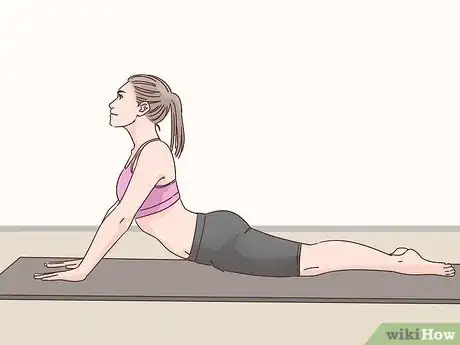This article was co-authored by Francisco Gomez. Francisco Gomez is the Head Coach at the FIT Potato Gym, a training gym established in 2001 in the San Francisco Bay Area. Francisco is a former competitive runner who helps endurance athletes train for major marathons like the Boston Marathon. Francisco specializes in Injury Rehab, Flexibility, Marathon Training, and Senior Fitness. He has a B.S. in Nutrition and Exercise Physiology & Running.
There are 7 references cited in this article, which can be found at the bottom of the page.
wikiHow marks an article as reader-approved once it receives enough positive feedback. In this case, 88% of readers who voted found the article helpful, earning it our reader-approved status.
This article has been viewed 50,869 times.
Deciding to run a race is a big step. And thinking about everything involved with the preparation of that race, especially if it's your first, can almost make you feel like you've already run it. But fear not – a big part of following through on your goal is to prepare yourself physically and keep yourself centered.
Steps
Obtaining the Right Gear
-
1Get the right shoes. The correct shoe will support your ankle, lock your heel into place, and give your toes enough room to wiggle around. Long-distance running shoes – anything over a 5k – are heavier because of added comfort. If you’re training for a shorter race, look for lighter-weight racing shoes to increase speed.[1]
- Each foot is made up differently. Experts can help you determine your unique foot characteristics to find shoes that support weaker areas. Your shoe should not just be on your foot, but part of it.
- Feet grow and change in small but significant ways with age, so don’t presume that a 3-year-old pair will fit even if they’re still in good shape.[2]
-
2Invest in comfortable clothes. Activewear fabrics like Dri-FIT are designed to move sweat away from the body, whereas traditional cotton absorbs it. By using lightweight, sweat-resistant clothing, your endurance will grow as you stay comfortable. You don’t need an entirely new wardrobe, either; just get a couple of the right products to cycle through.
-
3Carry a water bottle. If you plan to train with the water bottle in hand, opt for something smaller and with a nozzle for easier drinking on the go. If you can, plan a route that has water stations so you can refill it if you need to. Additionally, water-pack systems like those from CamelBak keep plenty of water in your reach without becoming tedious to maneuver.
- Plastic bottles can contain harmful chemicals, so when in doubt, opt for a stainless steel one.[3]
Preparing Yourself Mentally
-
1Write down the date of your race. Studies have found a link between writing down goals and following through with them. Make sure you do not stress yourself out too much, and try not to focus upon the crowd. Write down your race on something you will see each day, like a calendar or a sticky note on your desk. You want to prevent this goal from becoming an abstract concept for you.
-
2Develop a training schedule. The most successful training schedules incorporate consistency and variety harmoniously. The purpose of creating a schedule is to give yourself time to master a distance and then challenge yourself to raise it slowly until you’ve hit your distance goal.[4]
- Start by determining how far you can already run. If you can do an eight to ten mile run every week, you should train for a marathon for 18-20 weeks. If you cannot, you may need to train for longer or you might consider a shorter race.
- Use the 10% rule when creating your schedule, which says that you should not increase your mileage by more than 10% from week to week.[5]
-
3Hold yourself accountable. Finding someone to train with can be a huge step in manifesting your goal. If you want to train alone but still need motivation, find a friend to check in with on a weekly basis. The point is that you want to create an outside source to bolster your motivation.
- Fitness apps like Zombies, Run! and Fitocracy use a reward-based system for the work you do so you can see something tangible for being diligent.
- Remember why you made this goal in the first place. A big motivator will be finding the joy in your training.
Preparing Yourself Physically
-
1Mix up your exercise routine by cross training. Rest your running muscles from time to time by doing exercise that focuses on different muscle groups. Swimming, yoga, and pilates can keep your muscles warm while preventing possible burnout from focusing on a single activity.
- Gentle stretching helps soothe sore muscles, but overstretching can cause injury. Try some yoga poses, but do not do poses that are too deep. Lizard pose or inverted plank pose are great for runners.[6]
-
2Drink lots of water. Without proper hydration, your training schedule can quickly fall off-track. Your recovery time will take longer, your muscles will burn deeper, and your drive and dedication will most likely falter. When running long distances during training, you should drink water at least every 20-30 minutes, or more if you need it.[7]
-
3Eat a well-rounded diet. Limit the number of processed foods you eat, like candy and fast food. Instead, focus mostly on fresh foods that don’t have a nutrition label – things like fruits, vegetables, and fish.[8]
- Good sources of healthy complex carbohydrates include quinoa, brown rice, and whole-grain pasta.
- Chicken, fish, eggs, and legumes are all great sources of protein.
- Healthy fats consist of all kinds of nut varieties (pistachios, peanuts, almonds) as well as avocados and olive, canola, and coconut oils.[9]
- Eat a snack high in carbs and protein within an hour after finishing a run to replenish energy quickly.
Expert Q&A
-
QuestionHow do you prepare yourself for a long-distance race?
 Francisco GomezFrancisco Gomez is the Head Coach at the FIT Potato Gym, a training gym established in 2001 in the San Francisco Bay Area. Francisco is a former competitive runner who helps endurance athletes train for major marathons like the Boston Marathon. Francisco specializes in Injury Rehab, Flexibility, Marathon Training, and Senior Fitness. He has a B.S. in Nutrition and Exercise Physiology & Running.
Francisco GomezFrancisco Gomez is the Head Coach at the FIT Potato Gym, a training gym established in 2001 in the San Francisco Bay Area. Francisco is a former competitive runner who helps endurance athletes train for major marathons like the Boston Marathon. Francisco specializes in Injury Rehab, Flexibility, Marathon Training, and Senior Fitness. He has a B.S. in Nutrition and Exercise Physiology & Running.
Fitness Coach If you’re new to running long distances, give yourself extra time to train so you don’t hurt yourself. If the average 5k training program is 3 weeks, give yourself 5 or 6 weeks. If the average marathon training program is 16 to 18 weeks, give yourself 18 to 20.
If you’re new to running long distances, give yourself extra time to train so you don’t hurt yourself. If the average 5k training program is 3 weeks, give yourself 5 or 6 weeks. If the average marathon training program is 16 to 18 weeks, give yourself 18 to 20. -
QuestionHow should I prepare for a race in a week?
 Francisco GomezFrancisco Gomez is the Head Coach at the FIT Potato Gym, a training gym established in 2001 in the San Francisco Bay Area. Francisco is a former competitive runner who helps endurance athletes train for major marathons like the Boston Marathon. Francisco specializes in Injury Rehab, Flexibility, Marathon Training, and Senior Fitness. He has a B.S. in Nutrition and Exercise Physiology & Running.
Francisco GomezFrancisco Gomez is the Head Coach at the FIT Potato Gym, a training gym established in 2001 in the San Francisco Bay Area. Francisco is a former competitive runner who helps endurance athletes train for major marathons like the Boston Marathon. Francisco specializes in Injury Rehab, Flexibility, Marathon Training, and Senior Fitness. He has a B.S. in Nutrition and Exercise Physiology & Running.
Fitness Coach Take a little bit of time off so that you don't show up to the race worn down. Complete only 50% of your normal running routine, and that's at most. Make sure that you show up well-rested and hydrated. Finally, make sure that you're not showing up with some beat up shoes. If you're running a race, you want to make sure your feet can stand up to the task.
Take a little bit of time off so that you don't show up to the race worn down. Complete only 50% of your normal running routine, and that's at most. Make sure that you show up well-rested and hydrated. Finally, make sure that you're not showing up with some beat up shoes. If you're running a race, you want to make sure your feet can stand up to the task. -
QuestionHow do I know if I qualify for a race?
 Francisco GomezFrancisco Gomez is the Head Coach at the FIT Potato Gym, a training gym established in 2001 in the San Francisco Bay Area. Francisco is a former competitive runner who helps endurance athletes train for major marathons like the Boston Marathon. Francisco specializes in Injury Rehab, Flexibility, Marathon Training, and Senior Fitness. He has a B.S. in Nutrition and Exercise Physiology & Running.
Francisco GomezFrancisco Gomez is the Head Coach at the FIT Potato Gym, a training gym established in 2001 in the San Francisco Bay Area. Francisco is a former competitive runner who helps endurance athletes train for major marathons like the Boston Marathon. Francisco specializes in Injury Rehab, Flexibility, Marathon Training, and Senior Fitness. He has a B.S. in Nutrition and Exercise Physiology & Running.
Fitness Coach Most formal races will list their requirements online, so I'd just poke around on their social media accounts to find info on who is allowed to participate.
Most formal races will list their requirements online, so I'd just poke around on their social media accounts to find info on who is allowed to participate.
References
- ↑ Francisco Gomez. Competitive Runner. Expert Interview. 24 October 2019.
- ↑ http://www.webmd.com/fitness-exercise/features/8-weeks-to-your-first-race#1
- ↑ http://alphamom.com/parenting/parenting-products-services/best-water-bottles/
- ↑ Francisco Gomez. Competitive Runner. Expert Interview. 24 October 2019.
- ↑ http://www.runnersworld.com/running-tips/the-10-percent-rule
- ↑ http://www.mensjournal.com/health-fitness/articles/a-20-minute-yoga-routine-for-muscle-recovery-w435520
- ↑ Francisco Gomez. Competitive Runner. Expert Interview. 24 October 2019.
- ↑ http://www.mensfitness.com/nutrition/what-to-eat/adventure-race-nutrition-guide
- ↑ http://www.marathonguide.com/training/articles/Nutrition.cfm
About this article
To prepare for a race, stick to a training schedule that will prepare you for your race with specific runs, gentle stretches, and cross training activities. Additionally, cross train by swimming, biking, or doing yoga to increase your flexibility and strength. You'll also need to drink plenty of water before, after, and even during your longer runs to help muscles recover. Proper nutrition will also help your training, so make sure to eat a well balanced, healthy diet with plenty of fruits, vegetables, lean proteins, and healthy whole grain carbohydrates. For more tips from our Personal Training reviewer, including the best clothes to wear on race day, keep reading!




























